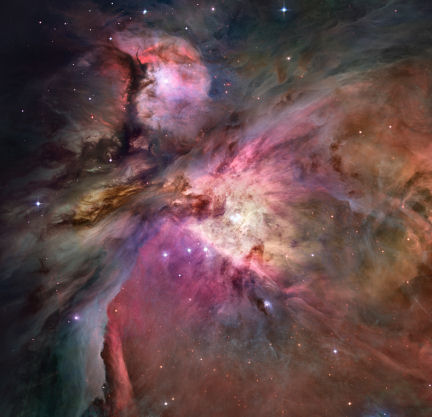From their earliest moments, massive stars play the heavy. As infants, their fierce winds and harsh ultraviolet radiation tear away at the fragile gas clouds in which their lighter-weight cousins are born. Eventually, these behemoths explode, dumping vast amounts of energy into space along with an assortment of heavy elements.

Yet for all the drama, astronomers aren’t quite sure how these rare, oversized stars form. Gas clouds—the material out of which all stars coalesce—typically divide into fragments much too small to make stars 10 to 100 times as massive as the sun.
In the Feb. 28 Nature, two theorists offer a partial solution to the puzzle. Mark Krumholz of Princeton University and the University of California, Santa Cruz, and Christopher McKee of the University of California, Berkeley, calculate that the gas in star-forming regions must have a minimum density in order to produce massive stars. The proposed threshold density not only explains the circumstances in which these stars form but accounts for their rarity, the researchers say.
Gas density plays a key role because it mediates star formation’s tug of war between gravity’s pull and gas pressure’s push. Gravity tends to break a large, star-forming gas cloud into chunks barely big enough to make sunlike stars. But the heat generated by these first, low-mass newborns increases the pressure in neighboring parts of the cloud, enabling them to resist breaking into such tiny pieces.
The larger fragments that are created would contain slightly more gas and therefore collapse to make a slightly more massive star—but still not enough to produce a true heavyweight. If the gas cloud has an unusually high density, though—packing roughly 100 times more mass than typical in the same small volume—then the larger cloud fragments could indeed produce stars many times as massive as the sun, Krumholz and McKee calculate. The density must exceed 100 times the usual density of a star-forming cloud, the researchers report.
Those densities are indeed attained in stellar nurseries known to contain massive stars, such as the Orion nebula and the Cygnus X region, Krumholz notes.
Observers are also providing new insight into the birth of massive stars. Using a submillimeter telescope to peer into 21 dense, massive star–forming regions, Henrik Beuther and his colleagues at the Max Planck Institute for Astronomy in Heidelberg, Germany, have for the first time found a chemical compound present throughout the process of massive star birth. The reactive molecule ethynyl (C2H) persists, so its emissions can reveal the temperature, density, and other properties of massive star–forming regions, the researchers report in the March 1 Astrophysical Journal Letters.
Within a massive star–birthing region, “one usually finds one [gas] molecule at early evolutionary stages that then vanishes with time, whereas other molecules need time to form and are only found in later stages,” notes Beuther. His team’s findings suggest ethynyl “could be a very good tool to investigate the gas properties [from] the earliest stages of massive star formation.”
Massive star–forming regions have a rich chemistry, but it has been difficult to fit all the chemical compounds “into some sort of evolutionary sequence,” notes Krumholz. “The ethynyl result is very promising for this.”







